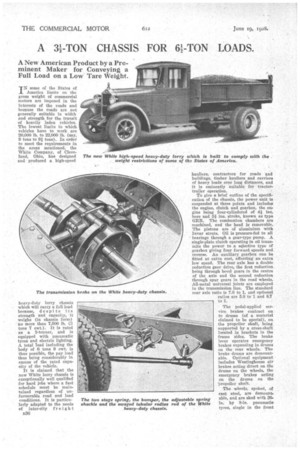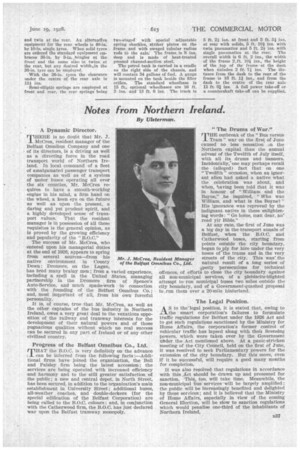A 3-1-TON CHASSIS FOR 6;-TON LOADS.
Page 62

Page 63

If you've noticed an error in this article please click here to report it so we can fix it.
A New American Product by a Prominent Maker for Conveying a Full Load on a Low Tare Weight.
IN some of the States of America limits on the gross weight of commercial motors are imposed in the interests of the roads and because the roads are not generally suitable in width and strength for the transit of heavily laden vehicles. The lowest limits to which vehicles have to work are 20,000 lb. to 22,000 lb. (say,
tons to 91 tons). In order to meet the requirements in the areas mentioned, the White Company, of Cleveland, Ohio, has designed and produced a high-speed
heavy-duty lorry chassis which will carry a full load because, despite its strength and capacity, it weighs (in chassis form) no more than 7,500 lb. (3 tons 7 cwt.). It is rated as a 3-tanner, and is equipped with pneumatic tyres and electric lighting. A total load including the body of 6 tons 9 cwt. is thus possible, the pay load thus being considerably in excess of the rated capacity of the vehicle.
It is claimed that the new White lorry chassis is exceptionally well qualified for hard jobs where a fast schedule must be maintained regardless of unfavourable road and load conditions. It is particularly adapted to the needs of inter-city f r a ight 1336 hauliers, contractors for roads and buildings, timber hauliers and carriers of heavy loads over long distances, and it is eminently suitable for tractortrailer operation.
To give a brief outline of the specification of the chassis, the power unit is suspended at three points and includes the engine, clutch and gearbox, the engine being four-cylindered of 41 ins. bore and 5i ins. stroke, known as type GRB. The combustion chambers are machined, and the head is removable. The pistons are of aluminium with Invar struts. Oil is pressure-fed to all bearings through a gear-type pump. A single-plate clutch operating in oil transmits the power to a selective type of gearbox giving four forward speeds and reverse. An auxiliary gearbox can be fitted at extra cost, affording an extra low speed. The rear axle has a double reduction gear drive, the first reduction being through bevel gears in the centre of the axle and the second reduction through spur gears in the road wheels. All-metal universal joints are employed in the transmission line. The standard rear axle ratio is 7.6 to 1, and optional ratios are 5.8 to 1 and 8.7 to 1.
The pedal-applied service brakes contract on to drums (of a material claimed to be special), on the propeller shaft, being supported by a cross-shaft located in brackets in the frame sides. The brake lever operates emergency brakes expanding in drums on the rear wheels. The brake drums are demountable. Optional equipment includes Westinghouse air brakes acting direct on the drums on the wheels, the emergency brakes acting on the drums on the propeller shaft.
The wheels, spoked, of cast steel, are demountable, and are shod with 36in. by 8-in. pneumatic tyres, single in the front
and twin at the rear. An alternative equipment for the rear wheels is 40-in. by 10-in, single tyres. When solid tyres are ordered the standard equipment etabraces 36-in. by 5-in. !singles at the front and the same size ; in twins: at the rear, but any desired witith,in the 36-in. tyre can be employed.
• With the 36-in. tyres the clearance under the centre of. the rear axle is 111 ins.
• Semi-elliptic springs are employed at front and rear, the rear springs being two-staged with special adjustable spring shackles, striker plates on the frame and with swaged tubular radius rods ti the axle: 'The frame.is 8 ins. deep and is made of heat-treated pressed channel-section steel.
The petrol tank is carried in a cradle on the right side of the chassis, and will contain 34 gallons of fuel. A gauge is mounted on the tank beside the filler orifice. The standard wheelbase is 15 ft., optional wheelbases are 16 ft. 3 ins. and 13 ft. 6 ins. The track is
5 ft. 21 ins, at front and 5 ft. 31 ins. at rear with solids, 5 ft. 10/ ins. with twin pneumatics and 5 ft. 2i ins, with single pneumatics at the rear. The overall width is 6 ft. 2 ins., the width of the frame 2.ft. 10/ ins., the height of the top of the frame., at the dash when unladen 2 in 7i ins. The distance from the dash to the rear of the frame is 16 ft. 11 ins., and from the dash to the centre of the rear axle 11 ft. 6/ ins. A full power take-off or a countershaft take-off can be supplied.




















































































































